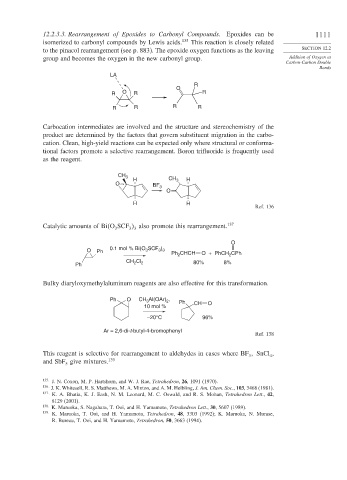Page 1135 - Advanced Organic Chemistry Part B - Reactions & Synthesis
P. 1135
12.2.3.3. Rearrangement of Epoxides to Carbonyl Compounds. Epoxides can be 1111
isomerized to carbonyl compounds by Lewis acids. 135 This reaction is closely related
to the pinacol rearrangement (see p. 883). The epoxide oxygen functions as the leaving SECTION 12.2
group and becomes the oxygen in the new carbonyl group. Addition of Oxygen at
Carbon-Carbon Double
Bonds
LA
R
O
R O R R
R R R R
Carbocation intermediates are involved and the structure and stereochemistry of the
product are determined by the factors that govern substituent migration in the carbo-
cation. Clean, high-yield reactions can be expected only where structural or conforma-
tional factors promote a selective rearrangement. Boron trifluoride is frequently used
as the reagent.
CH 3 CH
O H 3 H
BF 3
O
H H
Ref. 136
Catalytic amounts of Bi O SCF also promote this rearrangement. 137
3 3 3
O
0.1 mol % Bi(O SCF )
O Ph 3 3 3
Ph 2 CHCH O + PhCH CPh
2
CH Cl 80% 8%
Ph 2 2
Bulky diaryloxymethylaluminum reagents are also effective for this transformation.
Ph O CH Al(OAr) , Ph
3
2
10 mol % CH O
–20°C 96%
Ar = 2,6-di-t-butyl-4-bromophenyl
Ref. 138
This reagent is selective for rearrangement to aldehydes in cases where BF SnCl ,
3 4
and SbF give mixtures. 139
5
135 J. N. Coxon, M. P. Hartshorn, and W. J. Rae, Tetrahedron, 26, 1091 (1970).
136 J. K. Whitesell, R. S. Matthews, M. A. Minton, and A. M. Helbling, J. Am. Chem. Soc., 103, 3468 (1981).
137
K. A. Bhatia, K. J. Eash, N. M. Leonard, M. C. Oswald, and R. S. Mohan, Tetrahedron Lett., 42,
8129 (2001).
138 K. Maruoka, S. Nagahara, T. Ooi, and H. Yamamoto, Tetrahedron Lett., 30, 5607 (1989).
139
K. Maruoka, T. Ooi, and H. Yamamoto, Tetrahedron, 48, 3303 (1992); K. Maruoka, N. Murase,
R. Bureau, T. Ooi, and H. Yamamoto, Tetrahedron, 50, 3663 (1994).

